Categorie di Prodotto
Nuovi Prodotti
Il Team Uno-X guida una bici da strada aerodinamica radicale e inedita al Tour de France 2024.
Prodotta dal marchio taiwanese (e sponsor del team Uno-X) Dare, la bici va contro la tendenza prevalente per le bici tuttofare, adottando invece un approccio iper-aerodinamico con poca considerazione apparente per il peso.
Prima dell'inizio della gara a Firenze, in Italia, abbiamo dato un'occhiata da vicino alla nuova bici presso l'hotel del team Uno-X.
Potrebbe essere questa la bici che aiuterà il team Uno-X a conquistare la sua prima vittoria nella gara più importante di questo sport?
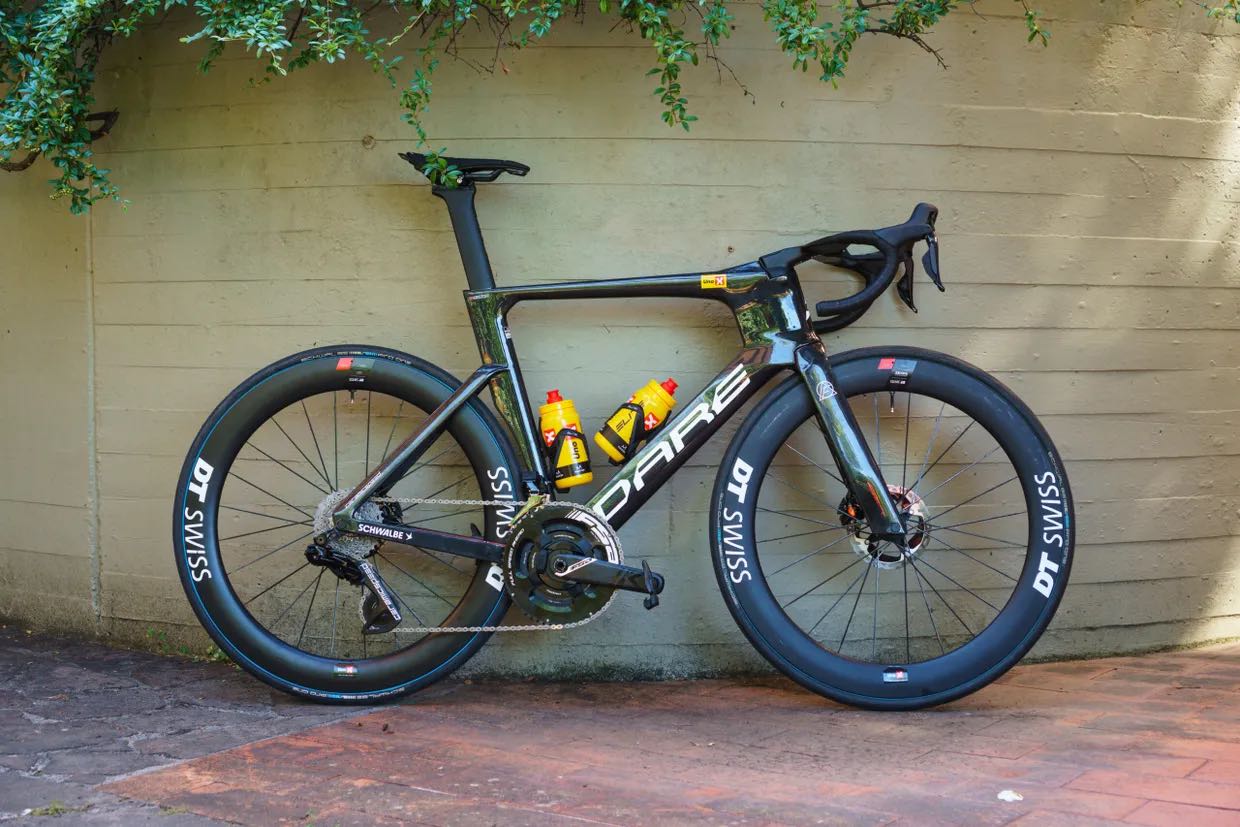
Restituzione della bici aerodinamica
Negli ultimi anni, abbiamo visto numerosi marchi importanti abbandonare le bici da strada aerodinamiche a favore di modelli che bilanciano prestazioni aerodinamiche con peso ridotto.

Specialized, ad esempio, ha messo al pascolo la sua S-Works Venge quando ha lanciato la S-Works Tarmac SL7 nel 2020, mentre la Madone SLR di ottava generazione recentemente annunciata da Trek ha segnato la fine della sua Émonda.
Allo stesso modo, il rilascio di una leggera Giant Propel Advanced SL nel 2022 ha visto l'iconico TCR del marchio relegato solo a un uso limitato nel WorldTour.
Dare sembra adottare l'approccio opposto, con un design più simile ad altre bici da strada aerodinamiche come Cervélo S5, Ribble Ultra SLR e Cannondale SystemSix Hi-Mod.
Per quanto ne sappiamo, la nuova bici da strada aerodinamica di Dare sembra essere chiamata "Velocity Ace", poiché è stampato sul tubo obliquo.
Molto probabilmente è un aggiornamento della bici aerodinamica esistente del marchio, la VSRu. La nuova bici, però, raddoppia le ottimizzazioni aerodinamiche, con forme dei tubi a profilo alare più profonde ovunque e una costruzione focalizzata interamente sulla velocità.
Tubi a sezione profonda a tutto tondo
Il tubo sterzo è una delle parti più sorprendenti della Velocity Ace.
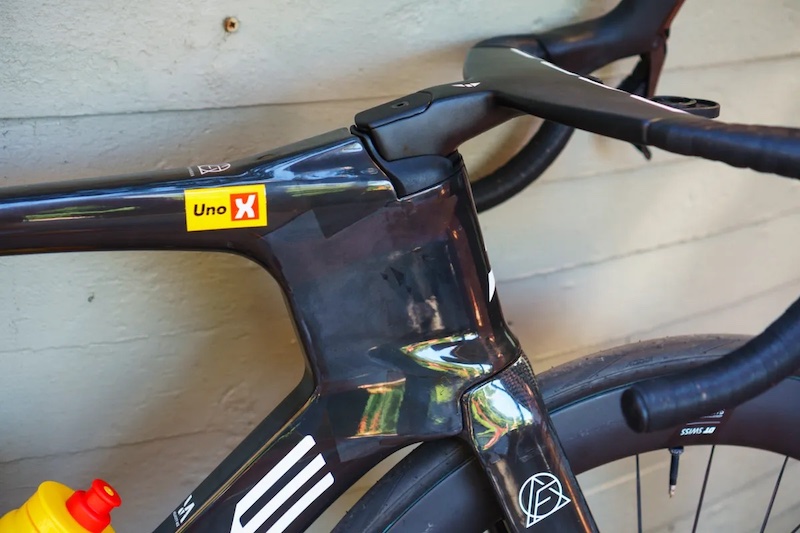
Utilizza un profilo alare profondo e troncato e si alza dal tubo superiore per incontrare la parte posteriore del nuovo manubrio integrato della bici (ne parleremo più avanti).
All'estremità inferiore, il tubo sterzo è scolpito per controllare il flusso d'aria dalla corona della forcella.
Visto frontalmente, il tubo sterzo è a forma di clessidra: si restringe tra i cuscinetti superiore e inferiore della serie sterzo per ridurre ulteriormente la resistenza
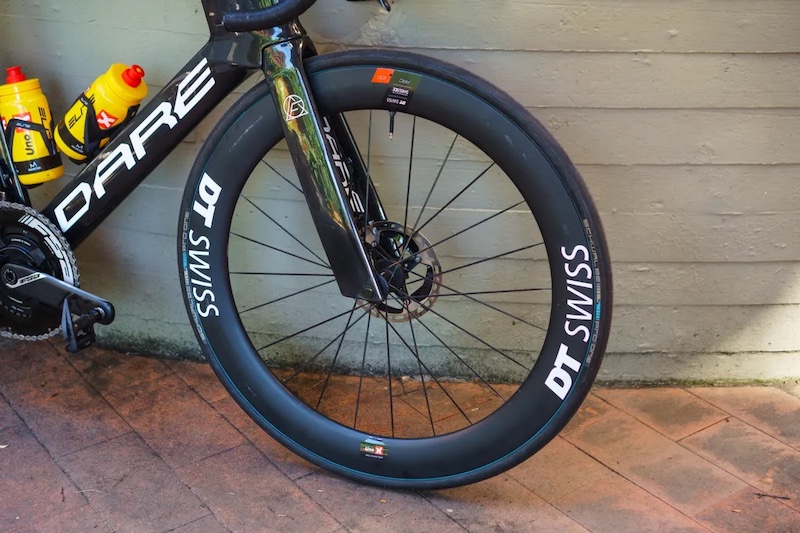
Mentre la forcella della VSRu si assottiglia leggermente verso il basso, gli steli a lama stretta della nuova forcella rimangono profondi fino in fondo.
Laddove il tubo obliquo della VSRu aveva un piccolo intaglio per la ruota anteriore, la Velocity Ace ha un tubo obliquo dritto con un profilo alare troncato più profondo e più ampio.
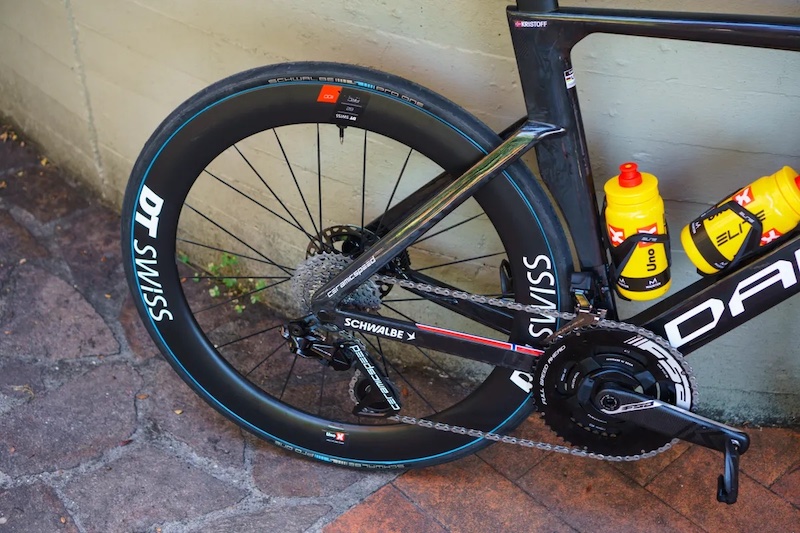
A differenza della nuova Trek Madone SLR, la Velocity Ace utilizza portaborracce standard non integrati con bottiglie d'acqua rotonde da ciclismo.
Tuttavia, è possibile che il tubo obliquo riprogettato fornisca una maggiore gestione del flusso d'aria intorno a quest'area rispetto a prima.
Nella parte posteriore della bici, anche i profili alare del tubo sella, dei foderi verticali e del reggisella sono stati notevolmente approfonditi.
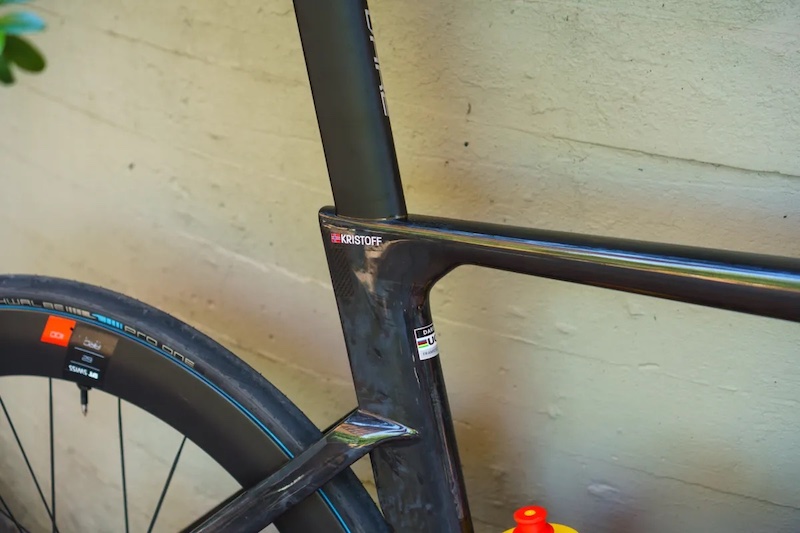
Resta da vedere se ciò avrà qualche impatto sulla conformità. A parte i foderi verticali, non sembra che Dare abbia fatto molte concessioni al comfort.
Like some time trial bikes, the seatpost appears to have multiple saddle clamp locations, enabling a rider to adjust the effective seat tube angle – an important consideration for fit purposes.
One of the deepest handlebars we’ve seen
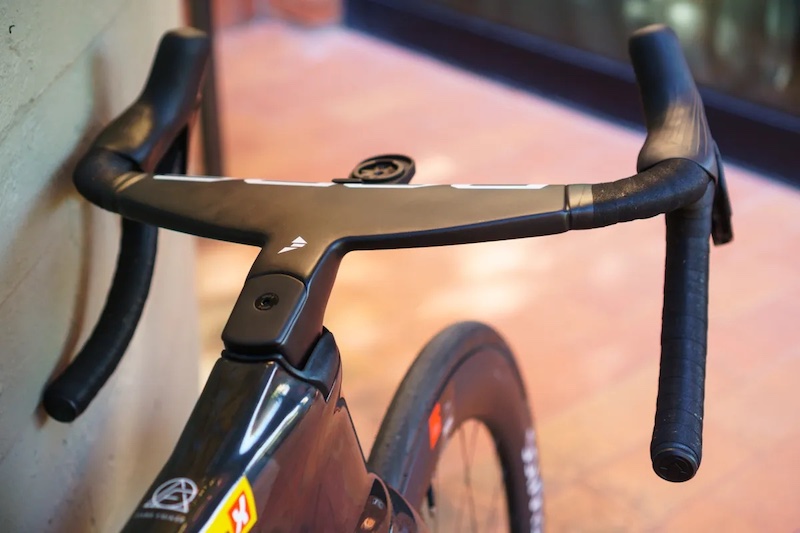
Beyond the head tube, the bike’s new aero handlebar is also remarkable, thanks to its use of an exceptionally deep and thin aerofoil profile on the tops.
Expectedly, the handlebar uses an integrated design, with the hydraulic brake hoses fully concealed within the bar and running into the frame unseen.The top tube rises to meet the rear of the stem, while the headset top cap has been cleverly profiled to smooth out the junction between the two.
Overall, Dare’s new bar appears to take the opposite approach to Ribble’s ground-breaking Ultra handlebar (which features on the Ultra SLR). The Ribble bar uses a similarly deep aerofoil profile, but is much more bulbous, as it’s designed to manipulate the airflow hitting the rider behind it.
Notably, Trek says the updated handlebar on its recently launched, eighth-generation Madone SLR does something similar (albeit on a smaller scale).
The Dare handlebar, in contrast, looks to be designed simply to reduce its impact on the airflow as much as possible.
As with rear-end comfort, there doesn’t seem to have been much consideration for a rider being able to hold the tops of the handlebar. As with the rest of the bike, it looks to be all about maximising aerodynamic efficiency.
On this bike, which belongs to four-time Tour de France stage winner, Alexander Kristof, the cockpit combines a 120mm-long stem with a 380mm-wide handlebar (measured centre to centre at the brake hoods).
The frame also has a logo noting the headset contains CeramicSpeed's SLT (Solid Lubrication Technology) bearings – which are claimed to provide exceptionally long lifespans, reducing the frequency with which the front end requires servicing.
A speed-focused build with personal upgrades
The rest of the build sees an uncompromising focus on speed.
Like last year, Kristof’s wheelset of choice is the DT Swiss ARC 1100 Dicut DB, with 62mm-deep rims.
These are wrapped with Schwalbe Pro One TLE tyres, in a 700 x 28c size that measures up at 27.9mm-wide on the DT Swiss rims.
As with last year, the tyres have conspicuous blue accents that don’t come on the versions of the Pro One TLE available in shops.
Having spotted these last year, we asked Schwalbe if this was a new, updated version of the German brand’s highly-rated tubeless tyre. Unfortunately, the brand declined to shed any light on the subject.
According to our well-informed YouTube audience, though, these could be special-edition, race day-only versions of the tyre – something faster, lighter but potentially less durable than the standard tyres, for example.
Schwalbe has apparently created similarly-branded tyres for its sponsored mountain bike athletes previously, so that could be what’s going on here.
As for the drivetrain, Kristof and his Uno-X team are still running Shimano’s flagship Dura-Ace Di2 R9200 groupset.
This year, though, the team has switched from using Shimano’s Dura-Ace FC-R9200-P power meter crankset to FSA’s Powerbox Team.
This consists of an FSA power meter spider (which we believe is made by Power2Max) paired with the brand's carbon cranks and aluminium chainrings.
When we saw Kristof’s bike, a couple of days out from the race start, it was equipped with some huge 56/40t chainrings.
Even though these were paired with a wide-ranging 11-34t cassette out back, we wonder whether Kristof might have swapped to something smaller for the race’s mountainous opening stage.
Perhaps due to a change in team sponsor, Kristof has switched saddles from the Pro Stealth Curved Team he used at last year’s Tour to a Prologo Scratch M5 with carbon rails.
Finishing things off, Kristof’s bike was also decked out with CeramicSpeed’s latest OSPW (Oversized Pulley Wheel System) RS Alpha and a waxed chain.
The 'Alpha Disc' solid pulley wheels are claimed to prevent dirt or debris entering the system and contaminating the bearings.
A new bike that’s heavier than the old one
It’s rare to see a new road bike released that’s significantly heavier than the outgoing version, but that’s exactly what we have here.
According to Dare, the VSRu had a claimed frame weight of 1,190g in a size small (although Kristof rides a 56cm frame). While we don’t yet have a claimed weight for Velocity Ace frame, we think its deeper tubes and aggressive aerodynamic optimisations have likely added weight.
That appears to be confirmed by the overall weight of Kristof’s Dare Velocity Ace, too, which came in at spot-on 8kg, according to our scales.
That’s 255g more than the 7.745kg weight we took for his Dare VSRu at last year’s Tour.
As things stand, that’s all we know about Dare’s radical new aero road bike.
Given a number of Uno-X riders are using the bike at this year’s Tour, it appears the bike is production ready and could launch imminently.
Frameset: Dare Velocity Ace (size 56cm) our Tour recycling have similar aero road carbon bike frames hotsale such as TDC-RD49,also developed new aero super weight road frame design TDC-RD55. these designs are more advanced and high performance in our customers. Welcome to send your inquiry to brand your new markets.
Groupset: Shimano Dura-Ace Di2 R9200 with FSA PowerBox Team power meter (56/40t chainrings, 11-34t cassette), FSA carbon cranks, CeramicSpeed OSPW RS Alpha and UFO waxed chain
Wheelset: DT Swiss ARC 1100 Dicut 62 DB
Tyres: Schwalbe Pro One TLE 29c (measured width 27.9mm)
Bar/stem: Dare, 38cm handlebar width, 12cm stem length
Seatpost: Dare
Saddle: Prologo Scratch M5 Nack
Bottle cages: Elite Vico Carbon
Pedals: Shimano Dura-Ace
NOTE: MAIN ARTICLE FROM WEBSITE